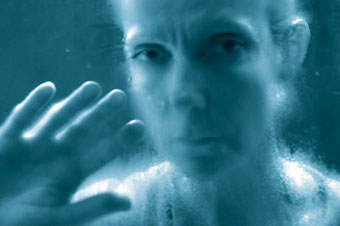Under the cover of night
Jeff Khan

Unheard Voices: Invisible by Night (detail, video still), 2004
While thousands swarmed to Melbourne’s Federation Square for mass karaoke sessions over the course of this year’s Melbourne International Arts Festival (see p38), a darker and altogether more sombre sort of interaction beckoned just metres away. As rapt members of the public momentarily lost themselves belting out I Will Survive, invoking the kind of heightened, escapist fantasy that only comes with karaoke, every evening Lynette Wallworth’s installation Unheard Voices: Invisible by Night quietly called passers-by to engage with the night in a very different way.
Installed in a rhomboid screen on one side of the Melbourne Visitor’s Centre, an angular, diminutive fragment of a building located on an outer corner of Federation Square, Unheard Voices was so modest in scale as to pass almost unnoticed by the pedestrian traffic. Closer inspection, however, revealed the mist-shrouded spectre of a female figure pacing back and forth, repeatedly approaching and then moving away from the foreground. When the viewer touched a small hand-shaped imprint on the screen, the figure again approached. But instead of turning away, she began to wipe away the mist which obscured the on-screen imagery. Slowly, she cleared a small area, partially revealing her face, looking mournfully out at the viewer before moving away, ending the silent encounter and returning the image to its hazy, ghostlike state.
Unheard Voices was inspired by the Federation Square site and its history as the location of Melbourne’s city morgue between 1871 and 1888, as well as its original function as a pre-colonisation meeting place for the Boonerwrung people. As Wallworth notes in her artist’s statement: “The sense that a site contains emanations of these complex layers, both pre and post colonisation is what intrigued me and the fact that, on this site, it should be linked with a sense of grieving seemed entirely appropriate.”
In a festival which took on the theme of ‘Voice’ and operated in an often celebratory mode, Unheard Voices staked an overt claim for the power of silence, its metaphorical equivalence with repressed or buried histories, and the importance of remembering, engaging, and grieving for the past.
From the haunting, restrained performance of Ivanka Sokol as the ghostly woman, providing an emotional resonance beyond the diminutive scale of the installation, to the intimate, gentle interface Wallworth developed with Daniel Horwood, Unheard Voices overcame its weighty, potentially didactic proposition to create a subtle, understated work. The open-ended nature of the encounter left ample space for viewers to locate themselves within the work as participants, thereby aligning the social and historical with the personal.
Meanwhile, on the eastern edge of Melbourne’s CBD, a similarly gothic work was playing out in a public facility of a different kind: the ladies’ toilet adjacent to Parliament Station. The Gordon Assumption was a collaborative installation by David Chesworth and Sonia Leber which utilised fragments of ‘found’ voices, decontextualising and reconfiguring them into something altogether striking and astounding. Like Unheard Voices, the installation operated under the cover of night when the public lavatory is usually closed. In contrast to Wallworth’s installation, The Gordon Assumption was anything but quiet and understated. Edited into a startlingly loud siren-like barrage, a multitude of voices were fragmented and spliced together with occasional brief choral interjections to create a continuous, modulating stream of sound. Rising and falling in pitch, the otherworldly wails tore out of the underground public conveniences creating a distorted, cacophonous soundscape which resounded through the Parliament Station precinct.
A dense catalogue essay attempted to contextualise The Gordon Assumption in terms of the Biblical Assumption of the Virgin Mary and other literary and theological sources. But the impact of the work was much more visceral, creating a rupture in the familiar, background noise of the city through a powerful sense of the spiritual and the uncanny, startling and fascinating commuters and passers-by. If anyone was game enough to brave descending the stairs the volume increased, and through the locked gate the facility was bathed in an eerie green light with a single bar of white light continually scanning its surfaces.
Like Unheard Voices, The Gordon Assumption powerfully suggested the return of the repressed, albeit in a less literal manner. Both works were deftly woven into the fabric of everyday Melbourne, disrupting the easy flow of city routine in a refreshingly dark, reflexive manner. Their highly considered site specificity enhanced and extended the democratic spirit of festival Director Robyn Archer’s inclusive vision over the past 3 Melbourne Festivals. In our forward-driven, increasingly blinkered culture, these installations made ominous and thought provoking claims for the importance of that which all too often falls out of earshot.
2004 Melbourne International Arts Festival Visual Arts Program: Lynette Wallworth, Unheard Voices: Invisible by Night, Melbourne Visitors Centre, October 5-23; David Chesworth and Sonia Leber, The Gordon Assumption, Gordon Reserve Toilets, October 7-23
RealTime issue #64 Dec-Jan 2004 pg. 39






